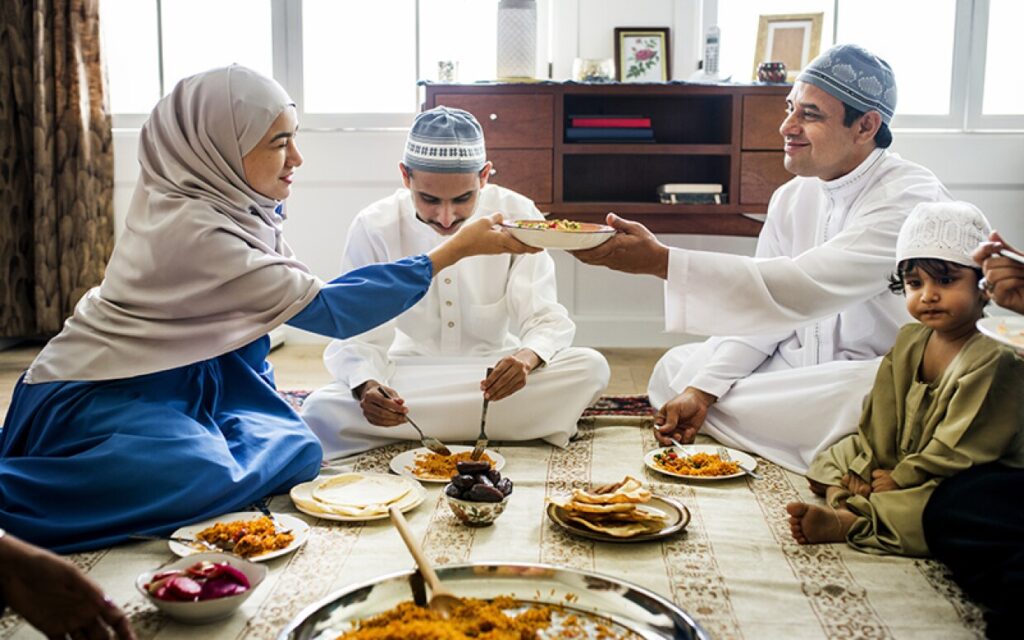Dining in the Arab world centers on hospitality and sharing. Meals typically involve a communal style of eating with a strong emphasis on generosity.
Exploring the dining customs in the Arab world reveals a rich cultural tapestry that delights both the palate and the spirit. These customs stress the importance of community and respect, with guests often treated with the highest level of honor.
The table is not just a place to eat; it’s a space for social connection, storytelling, and maintaining traditional values. Each meal serves as an opportunity to display kindness and to strengthen bonds among family and friends. As a visitor, embracing these dining practices is more than just enjoying delicious food—it’s an entry into the heart of Arab hospitality, characterized by warmth, inclusivity, and the celebration of togetherness.

Credit: www.familysearch.org
Introduction To Arab Dining Etiquette
Understanding dining etiquette in the Arab world is key to appreciating its rich culture. Food is not just nourishment; it’s a social pillar. Knowing the customs can enrich your dining experience.
Cultural Significance Of Food In The Arab World
Food in Arab culture is a celebration, a display of generosity and wealth. Meals are communal, often shared from the same plate. This practice promotes unity and reflects a long-standing tradition of togetherness at mealtimes.
- Communal dining symbolizes unity.
- Traditional dishes hold historical significance.
- Festivals and events center around feasts.
Role Of Hospitality In Arab Societies
In Arab societies, hospitality is paramount. Hosts take great pride in their ability to provide for guests. Invitations are extended with warmth, and guests are treated with the highest esteem. Refusing such kindness is not advised as it’s considered disrespectful.
- Guests receive a heartfelt welcome.
- Abundance in serving ensures comfort.
- Declining an invitation can offend.
Abide by these etiquettes, and you’ll likely find yourself wrapped in the warmth of Arab hospitality, an experience to cherish and remember.

Credit: sekkamag.com
Before The Meal: Preparation And Expectations
Welcome to a journey through the rich tapestry of Arab dining customs, where every meal is an affair of both hospitality and tradition. Understanding the preparation and expectations before the meal is crucial. It sets the stage for an immersive cultural experience.
Dress Code For Dining Occasions
Before setting foot into an Arab dining room, one’s attire speaks volumes. Guests typically opt for smart, conservative clothing. Men might wear long-sleeved shirts and trousers, while women often choose dresses or long skirts that cover the knees, paired with sleeves that reach at least the elbows. The emphasis is on modesty and respect for the host’s cultural norms.
Arrival And Greeting Customs
On arrival, punctuality shows respect. It is customary to bring a small gift, like sweets or pastries. Greetings play a crucial role; starting with the right hand is important. A handshake or two kisses on each cheek between same genders signifies warmth. For mix genders, a polite nod or hands placed over the heart suffice. These greetings convey respect and good intentions.
- Check invitation for specific arrival times.
- Choose an appropriate gift for the host.
- Greet with the right hand, or a polite gesture.
Cultural nuances in the Arab world are intricate. Proper dress and greeting etiquette set the right tone for a memorable dining experience. Join us as we delve deeper into the unique practices that define Arab hospitality.
Seating Arrangements And Beginning The Meal
When it comes to dining in the Arab world, traditions shape every aspect of the meal. From seating arrangements to washing hands and starting the meal, cultural norms guide guests and hosts alike. Let’s explore these practices to appreciate the blend of etiquette and heritage that adorn Arab dining experiences.
Understanding Hierarchical Seating
Seating is not random at an Arab dining table. The most respected person takes a specific spot, usually at the head of the table or in the center of a seating arrangement. This honor could be based on age, social status, or being a guest. Understanding this hierarchy sets the tone for a respectful dining experience.
- Highest status sits first
- Seats assigned based on respect
- Host guides guests to their spots
Proper Use Of Handwashing Stations
Hygiene precedes any meal in the Arab world. Often, a handwashing ritual takes place. Servers may bring a basin and jug, or guests are directed to a sink area. Using the right hand for cleaning before a meal is essential, following the traditions of cleanliness.
- Always use the right hand to wash
- Wash before sitting down
- Repeat after the meal
Commencement Rituals Before Eating
The meal begins only after everyone is seated and has washed their hands. A common ritual is the host or the eldest person saying “Bismillah” (In the name of God). This phrase sets a respectful and grateful tone for the meal. Everyone waits for this cue before they start eating.
| Step | Action |
|---|---|
| 1 | Wait for the cue from the host or elder |
| 2 | Say “Bismillah” or wait for it to be said |
| 3 | Begin eating with right hand |
During The Meal: Manners And Practices
Exploring dining customs in the Arab world is a journey into a rich tapestry of cultural traditions. Distinct manners and practices during meals reflect the region’s deep respect for hospitality and social etiquette. Let’s delve into the core customs that make mealtime both unique and engaging in Arabic societies.
Traditional Serving And Sharing Methods
In many Arab households, meals signify unity and generosity. Traditional serving often sees dishes placed at the center of a shared table or on a large platter called a ‘Sufra’. Guests typically gather around, forming a circle of communal enjoyment.
- Mezes or small appetizers come first.
- Main dishes follow, featuring proteins and rice.
- Sweets and fruits conclude the meal.
Navigating Utensils And Hand-eating
Eating with hands is common in many Arab cultures, and it comes with its own set of rules. The right hand is solely for eating, as the left is considered unclean.
- Wash hands before and after meals.
- Use bread as a utensil to scoop food.
- Utensils are present for specific dishes.
Conversations And Topics To Avoid
Engaging in polite conversation is integral to mealtime, yet certain topics are off-limits. Avoid sensitive subjects that may cause discomfort or offense.
- Stay clear of politics and religion.
- Avoid personal questions about family.
- Focus on positive topics: food, weather, or general well-being.
Ending The Meal Gracefully
Dining with Arab hosts is a warm and hospitable experience. Knowing how to wrap up a meal is as important as enjoying the feast itself. Let’s dive into the social cues and language that signal a meal’s end in the Arab world.
Signs And Signals For Meal Completion
During a gathering, certain gestures indicate the meal’s end. Watch for these to understand when it’s time to finish eating.
- Hosts may lean back or place their napkin on the table, showing they are done.
- Guests should follow suit, indicating they too are satisfied.
- When the tea or coffee is served, this usually means it’s time to wind down.
- A host’s verbal cue often accompanies physical signs, so stay attentive.
Appropriate Expressions Of Gratitude
Expressing thanks is critical in the Arab world. Use these phrases to show your appreciation for the meal and hospitality.
- Saying “Shukran” means “thank you” and is always well-received.
- Compliment the chef by saying, “Al-akl lazez,” which means “The food is delicious.”
- Praise the hospitality with, “Afwan,” acknowledging the effort taken.
- Before leaving, say “Ma’a as-salama,” which means “goodbye,” as a sign of respect.
Remember these practices to ensure a memorable and respectful dining experience.

Credit: kidskonnect.com
Special Occasions And Celebratory Feasts
In the Arab world, grand feasts and communal meals mark special occasions. Customs and culinary specialties reflect the region’s deep cultural heritage. During festivals and religious events, food brings people together in celebration. Let us explore two of the most significant occasions.
Ramadan Iftar: Breaking The Fast
The holy month of Ramadan holds a central place in Arab culture. It’s a time for spirituality, reflection, and community. Each day concludes with Iftar, the evening meal when families and friends gather to break their fast. Social media platforms buzz with images of these gatherings, showcasing tables laden with dates, soups, breads, and main dishes. Traditional beverages like qamar al-deen and tamar hindi rehydrate and refresh.
- Dates – Often the first food consumed to honor the Prophet’s tradition.
- Lentil Soup – A wholesome start to replenish energy levels.
- Sambusa – Triangular pastries stuffed with a variety of fillings.
Grilled meats and rice dishes such as Maqluba and Mansaf often feature as the centerpiece of Iftar. Sharing is key in these joyous times, with mosques and communities setting up tents to feed the less fortunate.
Eid Al-fitr And Eid Al-adha: Festive Gatherings
The conclusion of Ramadan brings forth Eid Al-Fitr, a jubilant day marked by special prayers and feasting. Eid Al-Adha, commemorating the willingness of Prophet Ibrahim to sacrifice his son in obedience to God, is equally festive. Both Eids embody the spirit of giving, family, and food.
| Dish | Description | Occasion |
|---|---|---|
| Maamoul | Delicious pastries filled with dates or nuts. | Eid Al-Fitr |
| Kabab | Grilled meat skewers, a barbecue favorite. | Eid Al-Adha |
| Baklava | Sweet pastry layers filled with nuts and syrup. | Both Eids |
During Eid, children often receive new clothes and gifts. Money, known as ‘Eidiyah’, is commonly given as well.
Charity is a big part of Eid celebrations. Families honor the tradition of ‘Udhiyah’ by distributing meat to those in need during Eid Al-Adha.
Frequently Asked Questions For Dining Customs In The Arab World,
What Is The Dining Etiquette In Arab Countries?
Arab dining etiquette emphasizes respect and hospitality. Always use your right hand for eating and passing dishes. Wait for the host’s cue before starting. Accept offered refreshments as a courtesy. Remember to compliment the meal and host graciously.
What Is The Food Culture Of The Arabs?
Arab food culture is rich and diverse, centered around flavors like cumin, coriander, and mint. Staple foods include lamb, rice, and bread. Meals often begin with mezze, small dishes to share, reflecting hospitality and community values. Traditional coffee and tea are significant social rituals.
What Are Arabs Eating Habits?
Arabs typically enjoy a diet rich in grains, meats, dairy, vegetables, and fruits. Traditional meals often include spices and flatbreads, with a focus on communal, leisurely eating practices. Dates and coffee are common for social occasions.
What Are The Customs Of Eating In Saudi Arabia?
Always wash your hands before eating. Meals typically start with soup or salad. Use your right hand for eating and passing dishes. Share dishes placed at the center of the table. Refrain from eating with your left hand due to cultural norms.
Conclusion
Exploring the rich tapestry of Arab dining traditions offers a window into a culture that prizes hospitality and communal ties. Remember, each meal is more than just food; it’s a cherished social event. Embrace these customs with respect and you’ll find every dinner an opportunity to deepen connections and create lasting memories.
As you venture into the Arab world, let your table manners be as fluent as your conversation.

